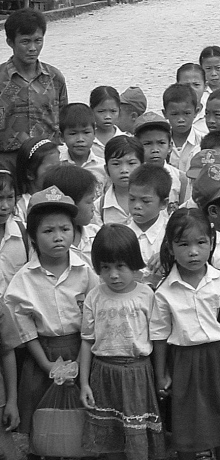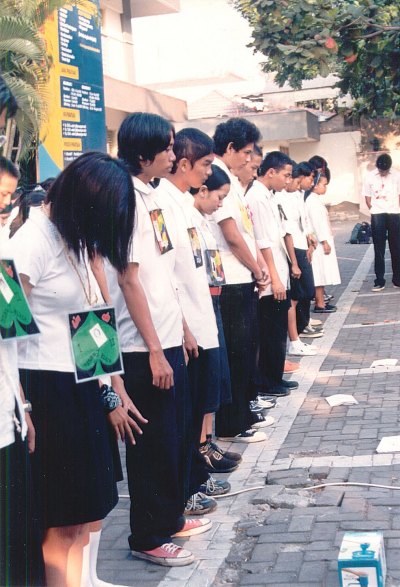A culture of violence in schools makes life tough for kids
Sharon Bessell
Bullying is widespread in the Indonesian education systemFJX (FOTOGRAFI) Jurnalistik (Kampus) Universitas Atma Jaya Yogyakarta |
I met 13 year old Ari when I was in Jakarta in 1995 interviewing children about school. When I asked him why he had dropped out of school, he shrugged and said ‘I guess I’m just stupid.’
Yet after getting to know Ari more, and talking about his experiences of school, it became clear that he had not dropped out because he was stupid – he was far from stupid. Rather, he had dropped out because he grew tired of being humiliated and yelled at by teachers and pushed around by other children. Violence, bullying and disrespect were at the heart of Ari’s decision to drop out of school. It seemed the only sensible course of action open to him.
More than a decade later, Indonesia has changed in ways that could barely be imagined in 1995. Yet some things still seem to be the same. Violence in schools remains a major problem – a problem many children are forced to deal with on a daily basis.
Bullying and hazing
Violence in schools and among students periodically captures local or national media attention, and when there is violence between groups of youths, public concern often escalates. In 2007, for example, the story of an 18 year old Jakarta high school student forced to leave school due to repeated episodes of bullying, including beatings, briefly made headlines. Another case to grab the spotlight in 2007 was that of Cliff Muntu, a 19 year old who died from a severe beating carried out under the euphemism of ‘hazing’. Hazing, the abuse and humiliation of fellow students, often as part of initiation into a group, has been a serious social problem in Indonesia for some time.
Children were beaten, forced to kneel for long periods, hit with an implement and had their ears twisted in some common forms of punishment
Beyond the individual stories that get media attention, there is increasing evidence that violence is widespread in Indonesian schools. Recent studies suggest that bullying is but one manifestation of a broader context of violence. Another is the use of severe and often arbitrary forms of punishment.
Violent punishment
Within Indonesian schools, violence and discipline often merge. Violent punishment is frequently used in place of non-violent forms of discipline. A 2005 Save the Children Sweden study found that children in the research sites of Maluku, North Maluku and West Timor were beaten, forced to kneel for long periods, hit with an implement and had their ears twisted in some common forms of punishment.
Interestingly, the study showed that the children viewed violent forms of punishment as inappropriate, harmful and often counterproductive. Children in West Timor suggested alternatives to violent punishment. As a punishment for fighting with other children – an offence that is often met with a beating – children suggested that they be made to draw or write a short story on the topic ‘what are friends for’. Rather than receiving an automatic beating for being late to school, children suggested that they be given the opportunity to explain why they are late.
Children also told the researchers that when they failed to complete their homework they were often forced to kneel for long periods, or were hit. A more effective alternative, they suggested, would be to revise homework questions so that children could better understand the task being asked of them. Children’s responses give us insights not only into the forms of violence used, but the broader culture and power hierarchies that are at play within many schools.
Culturally, violence is still seen as an effective way of enforcing discipline and educating a child
The study indicated that children are exposed to violent forms of punishment within school (and also at home) from a young age. While there are no studies in Indonesia to suggest a causal link, there are quite obvious questions about the relationship between children’s socialisation into violence through punishment and later activities such as bullying and hazing.
The policy framework
In recent years, child protection has received greater attention within Indonesia’s policy framework. The Indonesian Constitution, following the 2002 amendments, entitles children to protection from all forms of violence. The 2002 Law on Child Protection confers the right of children to be free from violence, exploitation, abuse, neglect and injustice (Article 13) in all areas of life. Article 54 of that law refers specifically to children’s right to protection from violence and abuse within the school. In a sharp departure from earlier laws, particularly the 1979 Child Welfare Act, the 2002 Law on Child Protection directly addresses issues of violence and provides a legislative foundation for preventative measures and rights-based responses. Yet this rhetorical commitment to ending violence within schools is yet to be matched by practical commitment, including the allocation of resources.
The role of teachers
 |
Children view violent forms of punishment
|
Teaching is a low-paid, under-valued occupation in Indonesia. Teachers regularly take on additional work in order to supplement their incomes. Class sizes are often large, buildings in a poor state and teachers under-trained and under-resourced. In such circumstances it is perhaps not surprising that teachers resort to violence and aggression. A key recommendation of the Save the Children Sweden study was the provision of more training and support to teachers to assist them in developing and using non-violent forms of discipline.
Similar sentiments have been expressed at the highest levels of policy making. The widespread use of severe punishment was highlighted at a 2006 seminar on ‘Child Friendly Schools’, hosted by the Ministry of Education, UNICEF, the Indonesian Commission on Child Protection and Save the Children UK. At the time, the Minister for Education, Bambang Sudibyo, was quoted as saying ‘culturally, violence is still seen as an effective way of enforcing discipline and educating a child. It is critical to train teachers in preventing and avoiding violence, including alternative ways of using discipline, stress management, and measures to protect children.’ In practice, however, the teacher training curricula in general fail to deal adequately with issues of class management and discipline. Many teachers, of course, play a central, supportive and caring role in children’s lives. But teachers generally remain without adequate – or any – training that will assist them to create a learning environment that does not revolve around the use of punishment, sometimes in a violent form.
Where to?
The education system remains a subject of intense debate in Indonesia, from the controversy surrounding the religious education requirements in the 2003 National Education System Bill, to the high cost of sending children to school, and the quality of education received by many Indonesian children. Within these debates and the politics that surround them, the problem of violence within schools should be a paramount concern.
The rhetorical commitment to ending violence within schools is yet to be matched by practical commitment
Unless violence is addressed through both public and political commitment – accompanied by the careful allocation of resources – the value and purpose of education must come into question. What role does education play when children are forced to cope with violence on a daily basis, and when children like Ari have no choice but to walk away from school? ii
Sharon Bessell (Sharon.Bessell@anu.edu.au) is a senior lecturer in the Crawford School of Economics and Government at the Australian National University. The Save the Children Sweden study investigated children’s and adults’ experiences and views of physical and emotional punishment in nine countries. The report, What Children Say, is available at www.scswedenseap.org
See also Campus cruelty by Akhmad Joko Purnomo (ii-edition 82)













